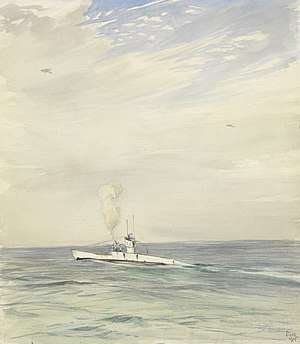HMS L2
HMS L2 was a L-class submarine built for the Royal Navy during World War I.
 HMS L2 by Francis Dodd | |
| History | |
|---|---|
| Name: | HMS L2 |
| Builder: | Vickers Limited, Barrow-in-Furness |
| Laid down: | 18 May 1916 |
| Launched: | 6 July 1917 |
| Commissioned: | 18 December 1917 |
| Fate: | Sold for scrapping, March 1930 |
| General characteristics | |
| Class and type: | L-class submarine |
| Displacement: |
|
| Length: | 231 ft 1 in (70.4 m) |
| Beam: | 23 ft 6 in (7.2 m) |
| Draught: | 13 ft 3 in (4.0 m) |
| Installed power: |
|
| Propulsion: |
|
| Speed: |
|
| Range: | 3,800 nmi (7,000 km; 4,400 mi) at 10 kn (19 km/h; 12 mph) on the surface |
| Test depth: | 100 feet (30.5 m) |
| Complement: | 35 |
| Armament: |
|
Design and description
The L-class boats were enlarged and improved versions of the preceding E class. The submarine had a length of 231 feet 1 inch (70.4 m) overall, a beam of 23 feet 6 inches (7.2 m) and a mean draught of 13 feet 3 inches (4.0 m). They displaced 891 long tons (905 t) on the surface and 1,074 long tons (1,091 t) submerged. The L-class submarines had a crew of 35 officers and ratings.[1]
For surface running, the boats were powered by two 12-cylinder Vickers[2] 1,200-brake-horsepower (895 kW) diesel engines, each driving one propeller shaft. When submerged each propeller was driven by a 600-horsepower (447 kW) electric motor.[1] They could reach 17 knots (31 km/h; 20 mph) on the surface and 10.5 knots (19.4 km/h; 12.1 mph) underwater.[3] On the surface, the L class had a range of 3,200 nautical miles (5,900 km; 3,700 mi) at 10 knots (19 km/h; 12 mph).[1]
The boats were armed with a total of six 18-inch (460 mm) torpedo tubes. Four of these were in the bow and the remaining pair in broadside mounts. They carried 10 reload torpedoes, all for the bow tubes.[4] L2 was initially fitted with a 3-inch (76 mm) anti-aircraft gun, but this was later replaced by a 4-inch (102 mm) deck gun.[5]
Construction and career
Originally laid down as E-class submarine E58 on 18 May 1916, she and sister ship E57 incorporated enough changes that they were renamed as the first pair of boats of a newly designated L class. L2 was launched 6 July 1917, and commissioned on 18 December 1917.
L2 survived an accidental attack by three American destroyers on 24 February 1918. The first heavy depth charge jammed the hydroplanes hard up. This caused a tremendous inclination to the stern with the tail of the submarine touching the sea bed at 300 feet (91 m). Four more heavy depth charges exploded shaking the boat. The skipper, Lieutenant-Commander Anworth, gave the order to blow the number 5 and 6 ballast tanks. L2 surfaced and came under fire by the three destroyers from about 1,500 yards (1,400 m). One shot struck the pressure hull just abaft the conning tower. The crew waved white ensigns and fired rifles and the destroyers ceased fire. She survived the encounter.
L2 was assigned to the 4th Submarine Flotilla and HMS Titania in 1919 and sailed to Hong Kong, arriving on 14 April 1920, and was placed in the Reserve Flotilla in Hong Kong in 1923. She was sold in March 1930, and arrived in April at Thos W Ward, Grays for break up.
Notes
- Gardiner & Gray, p. 93
- Harrison, Chapter 25
- Harrison, Chapters 3
- Harrison, Chapter 27
- Akermann, p. 165
References
- Akermann, Paul (2002). Encyclopaedia of British Submarines 1901–1955 (reprint of the 1989 ed.). Penzance, Cornwall: Periscope Publishing. ISBN 1-904381-05-7.
- Colledge, J. J.; Warlow, Ben (2006) [1969]. Ships of the Royal Navy: The Complete Record of all Fighting Ships of the Royal Navy (Rev. ed.). London: Chatham Publishing. ISBN 978-1-86176-281-8.
- Gardiner, Robert & Gray, Randal, eds. (1985). Conway's All the World's Fighting Ships: 1906–1921. Annapolis, Maryland: Naval Institute Press. ISBN 0-85177-245-5.
- Harrison, A. N. (January 1979). "The Development of HM Submarines From Holland No. 1 (1901) to Porpoise (1930) (BR3043)". Submariners Association: Barrow in Furness Branch. Archived from the original on 19 May 2015. Retrieved 19 August 2015.